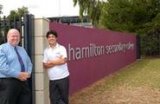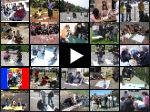Home page > Archives 2005-2006-2007 > 2007 Autumn
Lafrançaise, Yuba City, Adélaïde, Warren, Chillicothe
Lafrançaise
Lafrançaise (FR)
Latitude : 44°08’ N
Shadow :+94,5 cm —>N
Angle : + 43°20’
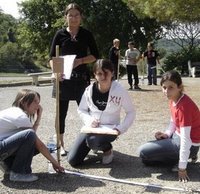
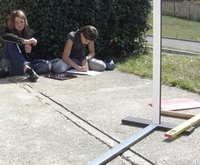
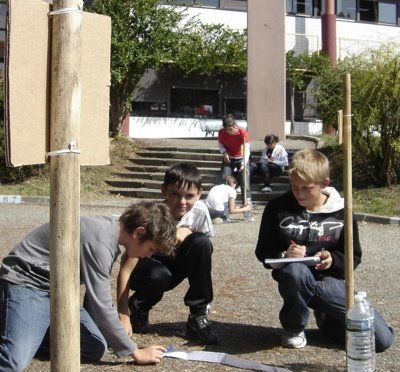
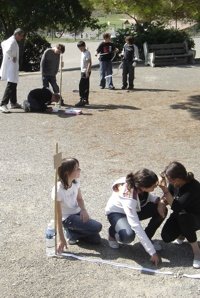
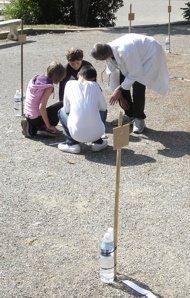
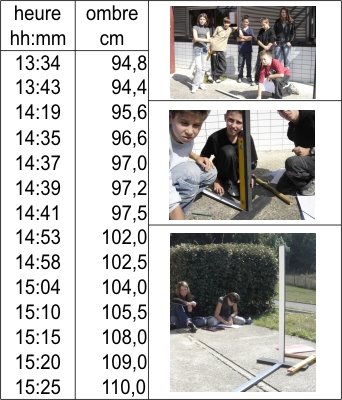
Yuba City, California, USA
Latitude : 39°06’ N
Shadow :+78,45cm—>N
Angle : + 38°10’
September 21, 2007
Latitude difference : 44°08’ -39°06’ = 05°02’ = 5,033°
Distance : 5,033 x 111,1 = 559 km
Angle difference: 43°20’ -(-38°06’) = 05°14’ = 5,233°
Circumference: 559 x 360° / 5,233° = 38 454 km
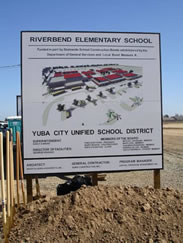 We are the first 6th grade class at a brand new school in Yuba City, California, USA, called Riverbend Middle School.
We are located in a farming community north of Sacramento.
We are the first 6th grade class at a brand new school in Yuba City, California, USA, called Riverbend Middle School.
We are located in a farming community north of Sacramento.
We are a math and science exploration class, which is an elective class offered for strong math students.
Throughout the year we will be studying both math and science through hands-on projects.
Our latitude is 39°05’15" N.
Our longitude is 121°36’04"W.
Thank you to all the classrooms sharing the wonder of new things with us!
Adélaïde, Australie
Adélaïde
Latitude : 35°00’ S
Shadow :+70,0 cm—>S
Angle : - 35°00’
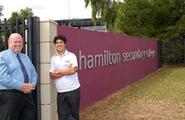 Hamilton Secondary college is a large secondary government school with both continuing students from grades 7-12 and also adult students who attend day and night classes in a variety of curriculum areas. We are situated in the southern suburbs of Adelaide around 6 km from the sea and 7 km from the CBD. Hamilton is the home of the South Australian Space School and we frequently have NASA astronauts visit our school.
Hamilton Secondary college is a large secondary government school with both continuing students from grades 7-12 and also adult students who attend day and night classes in a variety of curriculum areas. We are situated in the southern suburbs of Adelaide around 6 km from the sea and 7 km from the CBD. Hamilton is the home of the South Australian Space School and we frequently have NASA astronauts visit our school.
Students play a variety of sports including basketball, volleyball, netball,cricket, Aussie rules football, soccer and we also have a large number of students involved in rock climbing (we have a rock wall on site) and bike riding.
The Australian Rules Grand Final is to be played this week in Melbourne and the two teams playing are Geelong ( a town near Melbourne) and a team from Adelaide (Port Adelaide ’Power’). Over 40,000 people are expected to travel to Melbourne from Adelaide to watch the teams play.
We have a mediterranian climate here with temperatures ranging from 8-12 degrees C max in winter to 33-40 degrees C maximum in summer. At the moment we are in spring with temperatures around the mid twenties. There is 16.5 hours time difference between Adelaide and LA (on daylight saving) so that when it is 6pm on Sunday 23 September in LA it is 10.30 am in Adelaide.
September 21, 2007
Latitude difference : 44°08’ -(-35°00’) = 79°08’ = 79,133°
Distance : 79,133 x 111,1 = 8791 km
Angle difference: 43°20’ -(-35°) = 78°20’ = 78,333°
Circumference: 8791 x 360° / 78,333° = 40 401 km
Warren, Oregon,USA
 Mrs. Rosenthal’s 3rd grade advance math students took on the challenge of the noon day project. In Oregon the sun comes out for brief parts of the year and primarily in the summer. We are known for our liquid sunshine. My name is Catherine Hay, a parent volunteer whose love for math gave me the opportunity to work with this group.
On our best day for sun, the students learned the basic principles of measurements with a meter stick, and how to read one.
Mrs. Rosenthal’s 3rd grade advance math students took on the challenge of the noon day project. In Oregon the sun comes out for brief parts of the year and primarily in the summer. We are known for our liquid sunshine. My name is Catherine Hay, a parent volunteer whose love for math gave me the opportunity to work with this group.
On our best day for sun, the students learned the basic principles of measurements with a meter stick, and how to read one.
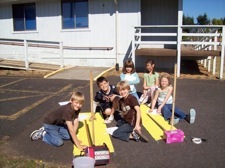 The next step was to understand the definition of perpendicular verses parallel. This was used when we constructed our shadow measurement tool. Parallel and perpendicular with the ground were used in our math vocabulary. We grouped into two teams, which measured and recorded data. This data was then brought back to the classroom and a comparison was done. These third graders then learned about approximation and how to analyze the data. From the data they watched the measurements decrease and were able to see that as the sun gets higher in the sky the shadow measurements got smaller. They also saw the data collected by the teams were different but were still decreasing. Base on the team’s measurements they then used their skills to produce a best approximation. Rounding was used to produce the measurement of 91.5 cm.
The next step was to understand the definition of perpendicular verses parallel. This was used when we constructed our shadow measurement tool. Parallel and perpendicular with the ground were used in our math vocabulary. We grouped into two teams, which measured and recorded data. This data was then brought back to the classroom and a comparison was done. These third graders then learned about approximation and how to analyze the data. From the data they watched the measurements decrease and were able to see that as the sun gets higher in the sky the shadow measurements got smaller. They also saw the data collected by the teams were different but were still decreasing. Base on the team’s measurements they then used their skills to produce a best approximation. Rounding was used to produce the measurement of 91.5 cm.
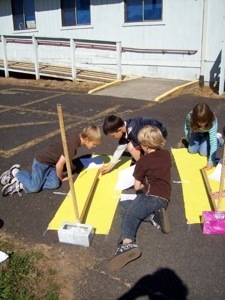 We then talked about what a protractor looks like and what it does. We related our findings to skateboarding. A 360 is a full circle, and a 180 is only a half of a circle. We also discussed that it is measuring degrees of an angle. We then constructed a right angle with two 100 cm sticks, which we say were perpendicular to each other to form the right angle 90 degrees. We marked our 91.5 on one stick and took a straight edge of butcher paper, from that point to the top of the other meter stick. We then measured the angle it created at the top our triangle. They came up with 45 degrees.
We then talked about what a protractor looks like and what it does. We related our findings to skateboarding. A 360 is a full circle, and a 180 is only a half of a circle. We also discussed that it is measuring degrees of an angle. We then constructed a right angle with two 100 cm sticks, which we say were perpendicular to each other to form the right angle 90 degrees. We marked our 91.5 on one stick and took a straight edge of butcher paper, from that point to the top of the other meter stick. We then measured the angle it created at the top our triangle. They came up with 45 degrees.
We then drew circles. 360 degrees. They used a protractor to mark off every 45 degree in a 360, coming up with 8.
 Because these are third graders, we used the program on the noonday site to measure the distance from our school to the equator. Our information resulted in 5075 km. They are just starting to understand their times table, so we worked on multiplying 5075 * 8 resulting in 40600 km. Not bad, considering they are learning. This then was related to the circumference around the earth, and we pulled out our globe to take another look.
Because these are third graders, we used the program on the noonday site to measure the distance from our school to the equator. Our information resulted in 5075 km. They are just starting to understand their times table, so we worked on multiplying 5075 * 8 resulting in 40600 km. Not bad, considering they are learning. This then was related to the circumference around the earth, and we pulled out our globe to take another look.
<
We then were given our partner school. This resulted in the group learning where Wharton, New Jersey is located. Because the schools are not North/South of each other, we used the program to calculate the distance from the equator for both schools.
Warren= 5075km; Wharton=4518km
We then subtracted them from one another to get 557km between them.
This then was used with the process of subtracting the schools angles. Warren at 45 degrees – 40 degrees of Wharton, to get 5 degrees. We then needed to find how many 5 degrees are in a 360. We got 72.
From this we then calculated 72 * 557= 40104 km as the circumference of the earth.
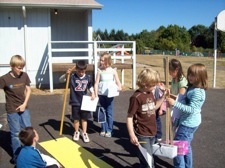 Our group had a ton of fun and the experience gave them great pride that they were completing a project along with older math students. Many math concepts were taught in a fun learning environment. We may be little but we are math strong.
Our group had a ton of fun and the experience gave them great pride that they were completing a project along with older math students. Many math concepts were taught in a fun learning environment. We may be little but we are math strong.
Chillicothe, Ohio , USA
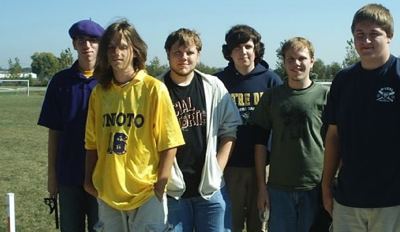
Greetings from Chillicothe, Ohio! Our 12th grade physics class divided into groups and gathered our data on September 21, 2007. Local noon was at 1:23 pm, so a team of students met at 1:05 pm and started to take measurements at 1:11 pm. We used rectangular meter sticks taped to bricks. We checked with a level to be sure the meter sticks were perpendicular. We had poster boards taped together under the meter sticks. We marked the edge of the meter stick, then the shadow’s edge every two minutes until 1:41 pm. Here are some pictures of the Measuring Team at work.
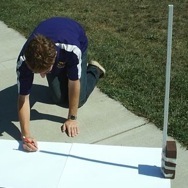

When our measurements were complete, the rest of the student teams went to work. They measured the length of each shadow line to find the shortest one, then they used trigonometry to find the sun angle measure. To do this, they found the ratio of the shortest shadow’s length in cm divided by the meter stick’s length of 100 m, then used inverse tangent (tan-1) to find the angle measure. Most of our angles were near 38 degrees.
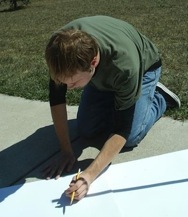
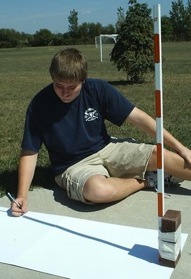
The next step was to choose a school in the Southern Hemisphere and combine our data with theirs. Their angle and our angle were added to find how large of a slice of the earth’s total angle measure from N to S we had combined. For instance, if their angle was 32 and ours was 38, we had a total of 70 degrees combined. By multiplying this angle measure by 111 kilometers per degree, we found the N – S distance between our locations.
Then we took 360 divided by 70 degrees to find the number of “slices” of this size in the whole earth. Finally, we multiplied the number of slices times the number of kilometers per slice to find the earth’s circumference. All of our teams were under 5% error. Until next year – this is Unioto High School, over and out!!
perbosc
This author's articles
![]() en
en
![]() Archives 2005-2006-2007
Archives 2005-2006-2007
![]() 2007 Autumn
?
2007 Autumn
?
